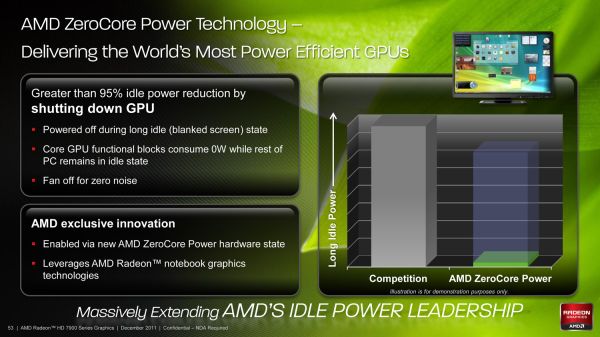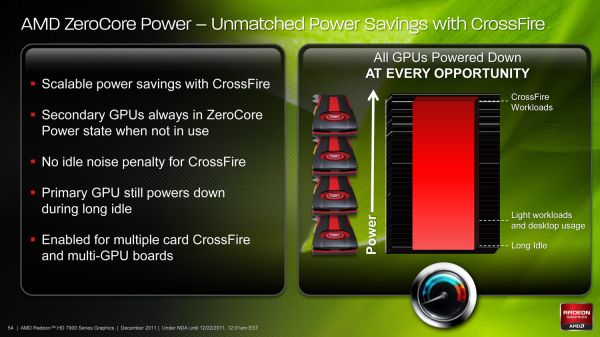AMD Radeon HD 7970 Review: 28nm And Graphics Core Next, Together As One
by Ryan Smith on December 22, 2011 12:00 AM EST- Posted in
- GPUs
- AMD
- Radeon
- ATI
- Radeon HD 7000
Managing Idle Power: Introducing ZeroCore Power
AMD has been on an idle power crusade for years now. Their willingness to be early adopters of new memory standards has allowed them to offer competitive products on narrower (and thereby cheaper) memory buses, but the tradeoff is that they get to experience the problems that come with the first revision of any new technology.
The most notable case where this has occurred would be the Radeon HD 4870 and 4890, the first cards to use GDDR5. The memory performance was fantastic; the idle power consumption was not. At the time AMD could not significantly downclock their GDDR5 products, resulting in idle power usage that approached 50W. Since then Cypress introduced a proper idle mode, allowing AMD to cut their idle power usage to 27W, while AMD has continued to further refine their idle power consumption.
With the arrival of Southern Islands comes AMD’s latest iteration of their idle power saving technologies. For 7970 AMD has gotten regular idle power usage down to 15W, roughly 5W lower than it was on the 6900 series. This is accomplished through a few extra tricks such as framebuffer compression, which reduce the amount of traffic that needs to move over the relatively power hungry GDDR5 memory bus.
However the big story with Southern Islands for idle power consumption isn’t regular idle, rather it’s “long idle.” Long idle is AMD’s term for any scenarios where the GPU can go completely idle, that is where it doesn’t need to do any work at all. For desktop computers this would primarily be for when the display is put to sleep, as the GPU does not need to do at work when the display itself can’t show anything.
Currently video cards based on AMD’s GPUs can cut their long idle power consumption by a couple of watts by turning off any display transmitters and their clock sources, but the rest of the GPU needs to be minimally powered up. This is what AMD seeks to change.
With Southern Islands AMD is introducing ZeroCore Power, their long idle power saving technology. By implementing power islands on their GPUs AMD can now outright shut off most of the functional units of a GPU when the GPU is going unused, leaving only the PCIe bus interface and a couple other components active. By doing this AMD is able to reduce their power consumption from 15W at idle to under 3W in long idle, a power level low enough that in a desktop the power consumption of the video card becomes trivial. So trivial in fact that with under 3W of heat generation AMD doesn’t even need to run the fan – ZeroCore Power shuts off the fan as it’s rendered an unnecessary device that’s consuming power.
Ultimately ZeroCore Power isn’t a brand new concept, but this is the first time we’ve seen something quite like this on the desktop. Even AMD will tell you the idea is borrowed from their mobile graphics technology, where they need to be able to power down the GPU completely for power savings when using graphics switching capabilities. But unlike mobile graphics switching AMD isn’t fully cutting off the GPU, rather they’re using power islands to leave the GPU turned on in a minimal power state. As a result the implementation details are very different even if the outcomes are similar. At the same time a technology like this isn’t solely developed for desktops so it remains to be seen how AMD can leverage it to further reduce power consumption on the eventual mobile Southern Islands GPUs.
Of course as impressive as sub-3W long idle power consumption is on a device with 4.3B transistors, at the end of the day ZeroCore Power is only as cool as the ways it can be used. For gaming cards such as the 7970 AMD will be leveraging it not only as a way to reduce power consumption when driving a blanked display, but more importantly will be leveraging it to improve the power consumption of CrossFire. Currently AMD’s Ultra Low Power State (ULPS) can reduce the idle power usage of slave cards to a lower state than the master card, but the GPUs must still remain powered up. Just as with long idle, ZeroCore Power will change this.
Fundamentally there isn’t a significant difference between driving a blank display and being a slave card card in CrossFire, in both situations the video card is doing nothing. So AMD will be taking ZeroCore Power to its logical conclusion by coupling it with CrossFire; ZeroCore Power will put CrossFire slave cards in ZCP power state whenever they’re not in use. This not only means reducing the power consumption of the slave cards, but just as with long idle turning off the fan too. As AMD correctly notes, this virtually eliminates the idle power penalty for CrossFire and completely eliminates the idle noise penalty. With ZCP CrossFire is now no noisier and only ever so slightly more power hungry than a single card at idle.
Furthermore the benefits of ZCP in CrossFire not only apply to multiple cards, but multiple-GPU cards too. When AMD launches their eventual multi-GPU Tahiti card the slave GPU can be put in a ZCP state, leaving only the master GPU and the PCIe bridge active. Coupled with ZCP on the master GPU when in long idle and even a beastly multi-GPU card should be able to reduce its long idle power consumption to under 10W after accounting for the PCIe bridge.
Meanwhile as for load power consumption, not a great deal has changed from Cayman. AMD’s PowerTune throttling technology will be coming to the entire Southern Islands lineup, and it will be implemented just as it was in Cayman. This means it remains operationally the same by calculating the power draw of the card based on load, and then altering clockspeeds in order to keep the card below its PowerTune limit. For the 7970 the limit is the same as it was for the 6970: 250W, with the ability to raise or lower it by 20% in the Catalyst Control Center.
On that note, at this time the only way to read the core clockspeed of the 7970 is through AMD’s drivers, which don’t reflect the current status of PowerTune. As a result we cannot currently tell when PowerTune has started throttling. If you recall our 6970 results we did find a single game that managed to hit PowerTune’s limit: Metro 2033. So we have a great deal of interest in seeing if this holds true for the 7970 or not. Looking at frame rates this may be the case, as we picked up 1.5fps on Metro after raising the PowerTune limit by 20%. But at 2.7% this is on the edge of being typical benchmark variability so we’d need to be able to see the core clockspeed to confirm it.












292 Comments
View All Comments
SlyNine - Friday, December 23, 2011 - link
Are you nuts, the 5870 was nearly 2x as fast in DX 10/9 stuff, not to mention DX11 was way ahead of DX10. Sure the 6970 isn't a great upgrade from a 5870, but neither is the 7970.Questionable Premise
CeriseCogburn - Thursday, March 8, 2012 - link
That happened at the end of 2006 with the G80 Roald. That means AMD and their ATI Radeon aquisition crew are five years plus late to the party.FIVE YEARS LATE.
It's nice to know that what Nvidia did years ago and recently as well is now supported by more people as amd copycats the true leader.
Good deal.
Hauk - Thursday, December 22, 2011 - link
A stunningly comprehensive analysis of this new architecture. This is what sets Anandtech apart from its competition. Kudos Ryan, this is one of your best..eastyy - Thursday, December 22, 2011 - link
its funny though when it comes to new hardware you read these complicated technical jargon and lots of detailed specs about how cards do things different how much more technically complicated and in the end for me all it means is...+15fps and thats about itas soon as a card comes out for say 150 and the games i play become slow and jerky on my 460 then i will upgrade
Mockingbird - Thursday, December 22, 2011 - link
I'd like to see some benchmarks on FX-8150 based system (990fx)piroroadkill - Friday, December 23, 2011 - link
Haha, the irony is that AMD is putting out graphics cards that would be bottlenecked HARDCORE by ANY of their CPUs, overclocked as much as you like.It's kind of tragic...
Pantsu - Friday, December 23, 2011 - link
The performance increase was as expected, at least for me, certainly not for all those who thought this would double performance. Considering AMD had a 389mm^2 chip with Cayman, they weren't going to double the transistor count again. That would've meant the next gen after this would be Nvidia class huge ass chip. So 64% more transistors on a 365mm^2 chip. Looks like transistor density increase took a bit of a hit on 28nm, perhaps because of 384-bit bus? Still I think AMD is doing better than Nvidia when it comes to density.As far as the chip size is concerned, the performance is OK, but I really question whether 32 ROPs is enough on this design. Fermi has 48 ROPs and about a billion transistors less. I think AMD is losing AA performance due to such a skimpy ROP count.
Overall the card is good regardless, but the pricing is indeed steep. I'm sure people will buy it nonetheless, but as a 365mm^2 chip with 3GB GDDR5 I feel like it should be 100$ cheaper than what it is now. I blame lack of competition. It's Nvidia's time to drop the prices. GTX 580 is simply not worth that much compared to what 6950/560Ti are going for these days. And in turn that should drop 7970/50 price.
nadavvadan - Friday, December 23, 2011 - link
Am I really tired, or is:" 3.79TFLOPs, while its FP64 performance is ¼ that at 947MFLOPs"
supposed to be:
" 3.79TFLOPs, while its FP64 performance is ¼ that at 947-G-FLOPs"?
Enjoyed the review as always.
Death666Angel - Friday, December 23, 2011 - link
Now that you have changed the benchmark, would it be possible to publish a .pdf with the relevant settings of each game? I would be very interested to replicate some of the tests with my home system to better compare some results. If it is not too much work that is (and others are interested in this as well). :Dmarc1000 - Friday, December 23, 2011 - link
What about juniper? Could it make it's way to the 7000 series as a 7670 card? Of course, upgraded to GCN, but with same specs as current cards. I guess that at 28nm it would be possible to abandon the pci-e power requirement, making it the go-to card for oem's and low power/noise systems.I would not buy it because I own one now, but I'm looking forward to 7770 or 7870 and their nvidia equivalent. It looks like next year will be a great time to upgrade for who is in the middle cards market.